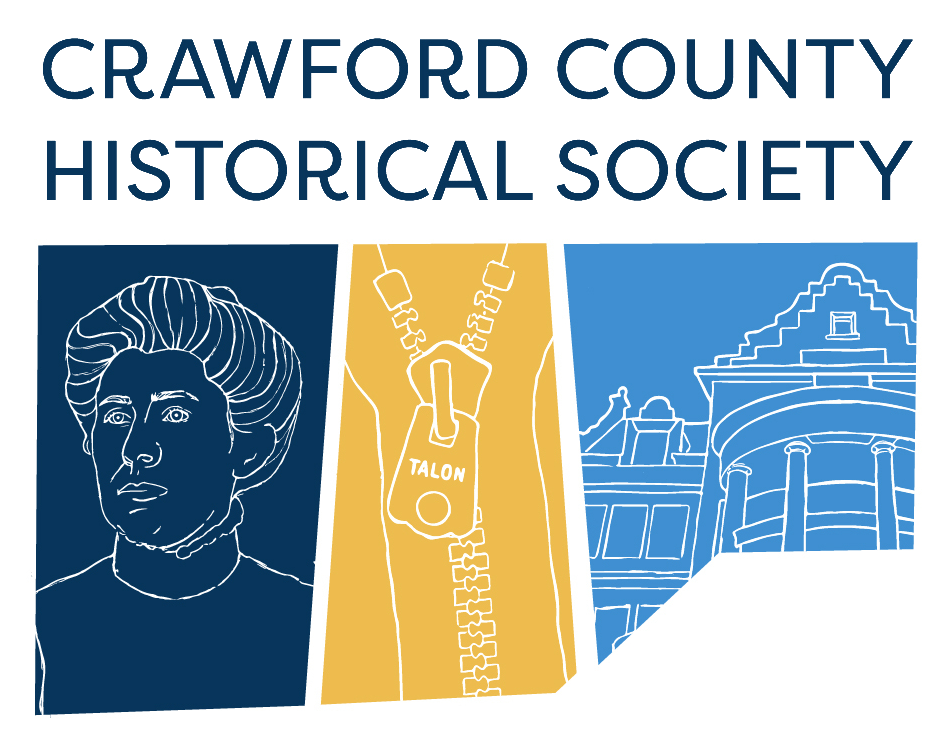JOHN BROWN IN CRAWFORD COUNTY
After leaving Hudson, John Brown lived longer in Pennsylvania than he did anywhere else, including North Elba. (While his family lived there for years, John Brown himself only lived six non-consecutive months in North Elba.[29]) According to a Pennsylvania friend who visited him in jail in Charles Town just before his execution, “he alluded to Crawford [County] as being very dear to him, as its soil was hallowed as the resting place of his former wife and two beloved children”.[30]
In 1825, despite the success of the tannery and having built a substantial house the year before, Brown and his family, seeking a safer location for fugitive slaves, moved to New Richmond, Pennsylvania. There he bought 200 acres (81 hectares) of land, cleared an eighth of it, and quickly built a cabin, a two-story tannery with 18 vats, and a barn; in the latter was a secret, well-ventilated room to hide escaping slaves.[31]: 4–5 [32] From 1825 to 1835, the tannery was an important stop on the Underground Railroad, and during this time, “Brown aided in the passing [to Canada] of an estimated 2,500 slaves.”[33]
Brown made money surveying new roads, and was involved in erecting a school, which first met in his home, and attracting a preacher.[26]: 23 [34]: 52 He also helped to establish a post office, and in 1828 President John Quincy Adams named him the first postmaster of Randolph, Pennsylvania; he was reappointed by President Andrew Jackson, serving until he left Pennsylvania in 1835.[26]: 23 [35]: 325 He carried the mail for some years from Meadville, Pennsylvania, through Randolph to Riceville, some 20 miles (32 km). He paid a fine at Meadville for declining to serve in the militia. During this period, Brown operated an interstate cattle and leather business along with a kinsman, Seth Thompson, from eastern Ohio.[31]: 7
In 1829, some white families asked Brown to help them drive off Native Americans who hunted annually in the area. Brown replied, “I will have nothing to do with so mean an act. I would sooner take my gun and help drive you out of the country.”[36]: 168–69 As a child in Hudson, John not only came into contact with the local Indians, he “hung about them… & learned a trifle of their talk”.[19]: 7 Throughout his life, Brown maintained peaceful relations with Native Americans, even accompanying them on hunting excursions and inviting them to eat in his home.[37][3]
Brown was involved in setting up a Congregational Society in Richmond, whose first meetings were held in the tannery.[31]: 6
Mary Ann Brown (née Day), wife of John Brown, married in 1833, with Annie (left) and Sarah (right) in 1851.
In 1831 Brown’s youngest son died, at the age of 4. Brown fell ill, and his businesses began to suffer, leaving him in severe debt. In the summer of 1832, shortly after the death of a newborn son, his wife Dianthe also died, either in childbirth or as an immediate consequence of it.[38]: 35 He was left with the children John Jr., Jason, Owen, and Ruth. On July 14, 1833, Brown married 17-year-old Mary Ann Day (1817–1884), originally from Washington County, New York;[39] she was the younger sister of Brown’s housekeeper at the time.[31]: 8 They would eventually have 13 children.[40][41] “He evinced a good deal of pride in stating that he had seven sons to help him in the cause” of abolishing slavery.[42]
Archival material concerning John Brown’s time in Crawford County, Pennsylvania, including his tannery, is held by the Pelletier Library, Allegheny College, Meadville, Pennsylvania.[43]
JOHN BROWN’S TANNERY
Located in Richmond Township, John Brown Farm, Tannery & Museum is a historic archaeological site. The tannery was built in 1825 by famed abolitionist John Brown (1800–1859), who lived on the site from 1825 to 1835. It was a major stop on the Underground Railway; Brown helped some 2,500 slaves during this period. The site includes the ruins of the tannery, a one-story, rectangular structure measuring 55 by 22 feet (16.8 by 6.7 m). There was a hidden, well-ventilated room in the barn for the fugitive slaves.
In 1874, in “a wonderful state of preservation”, it was converted into a cheese factory, and in 1884 it was turned into a steam grist-mill. “The structure is a relic of great historic interest, and is visited by thousands of curiosity and relic seekers, The windows and doors have all been chipped away. The Brown family have visited their old home several times within the past few years.”
A fire destroyed the building in 1907.
It was added to the National Register of Historic Places in 1978.
The graves of Brown’s first wife Dianthe, their four-year-old son Frederick (another son was named Frederick later), and an unnamed newborn son are nearby.
Today the historic site is maintained by the…
The John Brown Heritage Association exists to preserve the tannery site as a historic place. The JBHA also seeks to understand, research and interpret John Brown as a historic figure in the abolition of slavery, the lead-up to the Civil War and the advancement of racial equality in America. We welcome you to explore this website and learn more about the many facets of John Brown’s legacy.
